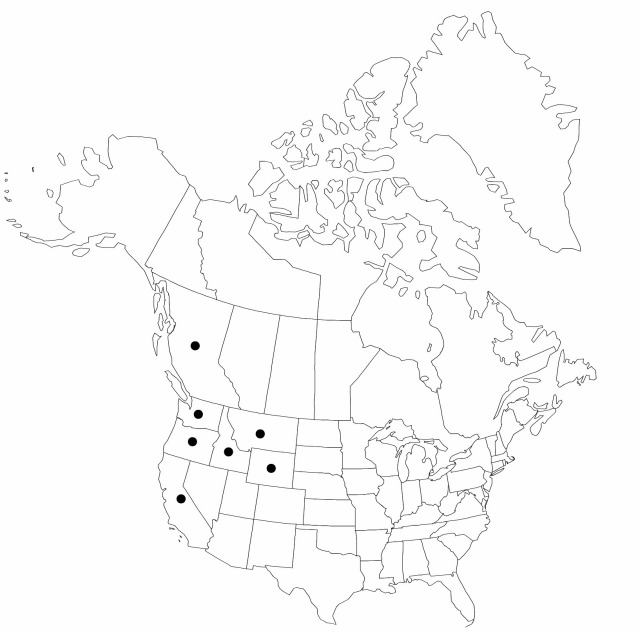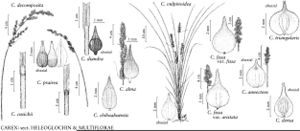Carex cusickii
Fl. N.W. Coast, 72. 1915.
Culms 3–130 cm. Leaves: sheaths adaxially red dotted and usually copper colored at mouth, concave at mouth, prolonged 1–4(–6) mm beyond base of blade; ligules 4.1–13.7 mm; foliage leaf blades 10–90 cm × 2.5–5(–6) mm. Inflorescences bisexual or, occasionally, nearly or wholly unisexual, flexuous and interrupted, proximal 0–5 branches (or spikes) often separated, decompound, (2–)3–8 × 1–2 cm; basal branch (when present) with 5–21 spikes (or ca. 40 spikes in very condensed inflorescences); proximal internode 4–12 mm. Pistillate scales straw colored or reddish brown, 2.5–3.4 × 1.5–2.1 mm, as wide as and equaling perigynia. Perigynia spreading, straw colored to light or dark brown, strongly 7–11-veined abaxially, with median lengthwise groove near base, with or without membranous flap toward apex, lance-ovate (body widely ovate to oblate) in outline, plano- to biconvex, 2.4–3 × 1.3–1.8 mm, shiny; beak 1–1.3 mm. Achenes broadly ellipsoid to broadly trullate-ovate or obovate in outline, 1.4–1.6 × 0.7–1.1 mm.
Phenology: Fruiting Jun–early Sep.
Habitat: Marshes, wet meadows, swales, sphagnum bogs, and other wet places, especially shores (sometimes on floating mats or rotten logs), also ditches
Elevation: 0–2100 m
Distribution

B.C., Calif., Idaho, Mont., Oreg., Wash., Wyo.
Discussion
Although infrequent or local in most parts of its range, Carex cusickii is fairly common in and west of the Cascade Mountains. Reports of C. cusickii from Utah probably are based on specimens of C. diandra. Carex cusickii is more similar to C. prairea than either species is to C. diandra. Both are typically more robust than the latter, having wider leaves and sometimes larger inflorescences and larger perigynia. The characteristics distinguishing the first two, although seemingly unimportant, are constant and appear to have populational significance. Furthermore, the geographic ranges of the species, although contiguous in the western part of the Cariboo Forest Region of southern British Columbia, are wholly discrete except for the remarkable occurrence of C. prairea in Flathead County, Montana. It remains to be determined if any real overlapping or recombining of characteristics occurs among the several species of section Heleoglochin, or whether the difficulty in drawing precise lines between them in the herbarium is merely the consequence of inadequate specimens and reliance on too few characters.
Selected References
None.
